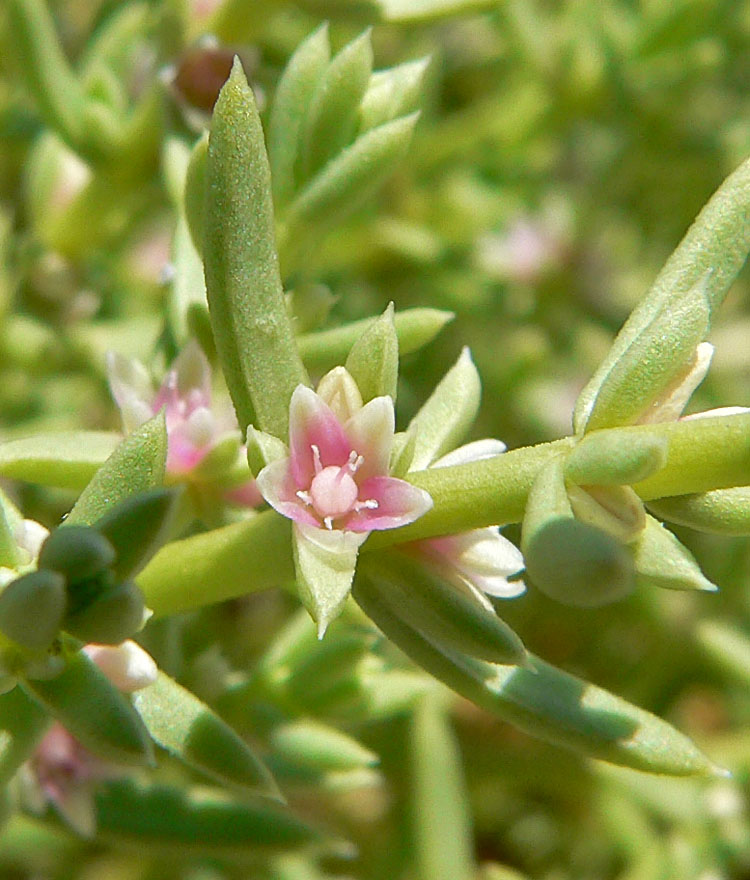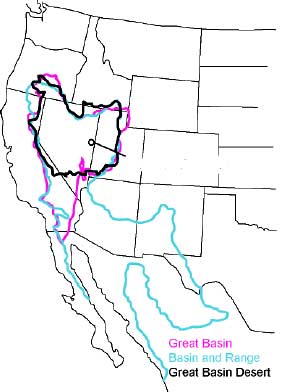|
Micromonolepis
''Micromonolepis pusilla'', (Syn. ''Monolepis pusilla'') is the only species of the genus ''Micromonolepis'' in the flowering plant family Amaranthaceae, known by the common names small povertyweed and red povertyweed. It is native to the Western United States, including the Great Basin and surrounding areas, where it grows in sandy scrub, dry valleys, playa Playa (plural playas) may refer to: Landforms * Endorheic basin, also known as a sink, alkali flat or sabkha, a desert basin with no outlet which periodically fills with water to form a temporary lake * Dry lake, often called a ''playa'' in the so ...s, and other open habitat. It is a somewhat fleshy annual herb producing a branching, slender stem that has a mealy whitish texture when young and turns dull to bright red with age, losing its grainy coat. It grows up to 14 to 20 centimeters tall. The thick oblong leaves are up to a centimeter long. Clusters of 1 to 3 minute flowers appear in the leaf axils, each flower made up ... [...More Info...] [...Related Items...] OR: [Wikipedia] [Google] [Baidu] |
Chenopodioideae
The Chenopodioideae are a subfamily of the flowering plant family Amaranthaceae in the APG III system, which is largely based on molecular phylogeny, but were included - together with other subfamilies - in family Chenopodiaceae in the Cronquist system. Food species comprise Spinach (''Spinacia oleracea''), Good King Henry (''Blitum bonus-henricus''), several '' Chenopodium'' species ( Quinoa, Kañiwa, Fat Hen), Orache (''Atriplex spp.''), and Epazote (''Dysphania ambrosioides''). The name is Greek for goosefoot, the common name of a genus of plants having small greenish flowers. Description The Chenopodioideae are annual or perennial herbs, subshrubs, shrub or small trees. The leaves are usually alternate and flat. The flowers are often unisexual. Many species are monoecious or have mixed inflorescences of bisexual and unisexual flowers. Some species are dioecious, like '' Spinacia'', '' Grayia'', '' Exomis'', and ''Atriplex''. In several species of tribe Atripliceae, ... [...More Info...] [...Related Items...] OR: [Wikipedia] [Google] [Baidu] |
Amaranthaceae
Amaranthaceae is a family of flowering plants commonly known as the amaranth family, in reference to its type genus '' Amaranthus''. It includes the former goosefoot family Chenopodiaceae and contains about 165 genera and 2,040 species, making it the most species-rich lineage within its parent order, Caryophyllales. Description Vegetative characters Most species in the Amaranthaceae are annual or perennial herbs or subshrubs; others are shrubs; very few species are vines or trees. Some species are succulent. Many species have stems with thickened nodes. The wood of the perennial stem has a typical "anomalous" secondary growth; only in subfamily Polycnemoideae is secondary growth normal. The leaves are simple and mostly alternate, sometimes opposite. They never possess stipules. They are flat or terete, and their shape is extremely variable, with entire or toothed margins. In some species, the leaves are reduced to minute scales. In most cases, neither basal nor terminal ... [...More Info...] [...Related Items...] OR: [Wikipedia] [Google] [Baidu] |
Amaranthaceae Genera
Amaranthaceae is a family of flowering plants commonly known as the amaranth family, in reference to its type genus ''Amaranthus''. It includes the former goosefoot family Chenopodiaceae and contains about 165 genera and 2,040 species, making it the most species-rich lineage within its parent order, Caryophyllales. Description Vegetative characters Most species in the Amaranthaceae are annual or perennial herbs or subshrubs; others are shrubs; very few species are vines or trees. Some species are succulent. Many species have stems with thickened nodes. The wood of the perennial stem has a typical "anomalous" secondary growth; only in subfamily Polycnemoideae is secondary growth normal. The leaves are simple and mostly alternate, sometimes opposite. They never possess stipules. They are flat or terete, and their shape is extremely variable, with entire or toothed margins. In some species, the leaves are reduced to minute scales. In most cases, neither basal nor terminal aggregat ... [...More Info...] [...Related Items...] OR: [Wikipedia] [Google] [Baidu] |
Oskar Eberhard Ulbrich
Oskar Eberhard Ulbrich (17 September 1879 – 4 November 1952) was a German botanist and mycologist. Ulbrich was born in Berlin. He studied natural sciences at the University of Berlin, where his instructors included Adolf Engler (1844–1930) and Simon Schwendener (1829–1919). In 1926 he became a curator and professor at the Botanical Museum in Berlin, where in 1938 he was appointed director of the ''Hauptpilzstelle''. Known for his intrafamilial investigations of the botanical families Amaranthaceae, Chenopodiaceae and Caryophyllaceae, in 1934 he subdivided Chenopodiaceae into eight subfamilies; Salicornioideae, Polycnemoideae, Chenopodioideae, Salsoloideae, et al. In 1911 he introduced usage of a color scheme to indicate geographical regions on herbarium specimens and fascicles. The plant genus ''Ulbrichia'' from the family Malvaceae was named after him by Ignatz Urban (1848–1931). Selected publications * ''Die höheren Pilze: Basidiomycetes'', third edition 1928 (with ... [...More Info...] [...Related Items...] OR: [Wikipedia] [Google] [Baidu] |
John Torrey
John Torrey (August 15, 1796 – March 10, 1873) was an American botanist, chemist, and physician. Throughout much of his career, he was a teacher of chemistry, often at multiple universities, while he also pursued botanical work, focusing on the flora of North America. His most renowned works include studies of the New York flora, the Mexican Boundary, the Pacific railroad surveys, and the uncompleted ''Flora of North America''. Biography Torrey was born in New York City, the second child of Capt. William and Margaret (née Nichols) Torrey.Robbins, C. C. (1968). John Torrey (1796–1873), His Life & Times. ''Bulletin of the Torrey Botanical Club''. Vol. 95, No. Nov. 6–Dec. 1968, 515–645. Torrey Botanical Club, New York. He showed a fondness for mechanics, and at one time planned to become a machinist. When he was 15 or 16, his father received an appointment to the state prison at Greenwich Village, New York, where he was tutored by Amos Eaton, then a prisoner ... [...More Info...] [...Related Items...] OR: [Wikipedia] [Google] [Baidu] |
Sereno Watson
Sereno Watson (December 1, 1826 in East Windsor Hill, Connecticut – March 9, 1892 in Cambridge, Massachusetts) was an American botanist. Graduating from Yale in 1847 in Biology, he drifted through various occupations until, in California, he joined the Clarence King Expedition and eventually became its expedition botanist. Appointed by Asa Gray as assistant in the Gray Herbarium of Harvard University in 1873, he later became its curator, a position he maintained until his death. Watson was elected a Fellow of the American Academy of Arts and Sciences in 1874, and a member of the National Academy of Sciences The National Academy of Sciences (NAS) is a United States nonprofit, non-governmental organization. NAS is part of the National Academies of Sciences, Engineering, and Medicine, along with the National Academy of Engineering (NAE) and the Nat ... in 1889. Works * ''Botany'', in ''Report of the geological exploration of the 40th parallel made ... by Clarence King ... [...More Info...] [...Related Items...] OR: [Wikipedia] [Google] [Baidu] |
Western United States
The Western United States (also called the American West, the Far West, and the West) is the region comprising the westernmost states of the United States. As American settlement in the U.S. expanded westward, the meaning of the term ''the West'' changed. Before about 1800, the crest of the Appalachian Mountains was seen as the western frontier. The frontier moved westward and eventually the lands west of the Mississippi River were considered the West. The U.S. Census Bureau's definition of the 13 westernmost states includes the Rocky Mountains and the Great Basin to the Pacific Coast, and the mid-Pacific islands state, Hawaii. To the east of the Western United States is the Midwestern United States and the Southern United States, with Canada to the north, and Mexico to the south. The West contains several major biomes, including arid and semi-arid plateaus and plains, particularly in the American Southwest; forested mountains, including three major ranges, the Sierra N ... [...More Info...] [...Related Items...] OR: [Wikipedia] [Google] [Baidu] |
Great Basin
The Great Basin is the largest area of contiguous endorheic watersheds, those with no outlets, in North America. It spans nearly all of Nevada, much of Utah, and portions of California, Idaho, Oregon, Wyoming, and Baja California. It is noted for both its arid climate and the basin and range topography that varies from the North American low point at Badwater Basin in Death Valley to the highest point of the contiguous United States, less than away at the summit of Mount Whitney. The region spans several physiographic divisions, biomes, ecoregions, and deserts. Definition The term "Great Basin" is applied to hydrographic, biological, floristic, physiographic, topographic, and ethnographic geographic areas. The name was originally coined by John C. Frémont, who, based on information gleaned from Joseph R. Walker as well as his own travels, recognized the hydrographic nature of the landform as "having no connection to the ocean". The hydrographic definition is the ... [...More Info...] [...Related Items...] OR: [Wikipedia] [Google] [Baidu] |
Dry Lake
A dry lake bed, also known as a playa, is a basin or depression that formerly contained a standing surface water body, which disappears when evaporation processes exceeds recharge. If the floor of a dry lake is covered by deposits of alkaline compounds, it is known as an alkali flat. If covered with salt, it is known as a '' salt flat.'' Terminology If its basin is primarily salt, then a dry lake bed is called a '' salt pan'', ''pan'', or ''salt flat'' (the latter being a remnant of a salt lake). ''Hardpan'' is the dry terminus of an internally drained basin in a dry climate, a designation typically used in the Great Basin of the western United States. Another term for dry lake bed is ''playa''. The Spanish word ''playa'' () literally means "beach". Dry lakes are known by this name in some parts of Mexico and the western United States. This term is used e.g. on the Llano Estacado and other parts of the Southern High Plains and is commonly used to address paleolake sediments ... [...More Info...] [...Related Items...] OR: [Wikipedia] [Google] [Baidu] |
Sepal
A sepal () is a part of the flower of angiosperms (flowering plants). Usually green, sepals typically function as protection for the flower in bud, and often as support for the petals when in bloom., p. 106 The term ''sepalum'' was coined by Noël Martin Joseph de Necker in 1790, and derived . Collectively the sepals are called the calyx (plural calyces), the outermost whorl of parts that form a flower. The word ''calyx'' was adopted from the Latin ,Jackson, Benjamin, Daydon; A Glossary of Botanic Terms with their Derivation and Accent; Published by Gerald Duckworth & Co. London, 4th ed 1928 not to be confused with 'cup, goblet'. ''Calyx'' is derived from Greek 'bud, calyx, husk, wrapping' ( Sanskrit 'bud'), while is derived from Greek 'cup, goblet', and the words have been used interchangeably in botanical Latin. After flowering, most plants have no more use for the calyx which withers or becomes vestigial. Some plants retain a thorny calyx, either dried or live, ... [...More Info...] [...Related Items...] OR: [Wikipedia] [Google] [Baidu] |
Flora Of The Western United States
Flora (: floras or florae) is all the plant life present in a particular region or time, generally the naturally occurring ( indigenous) native plants. The corresponding term for animals is ''fauna'', and for fungi, it is '' funga''. Sometimes bacteria and fungi are also referred to as flora as in the terms ''gut flora'' or ''skin flora''. Etymology The word "flora" comes from the Latin name of Flora, the goddess of plants, flowers, and fertility in Roman mythology. The technical term "flora" is then derived from a metonymy of this goddess at the end of the sixteenth century. It was first used in poetry to denote the natural vegetation of an area, but soon also assumed the meaning of a work cataloguing such vegetation. Moreover, "Flora" was used to refer to the flowers of an artificial garden in the seventeenth century. The distinction between vegetation (the general appearance of a community) and flora (the taxonomic composition of a community) was first made by Jules Thurm ... [...More Info...] [...Related Items...] OR: [Wikipedia] [Google] [Baidu] |







